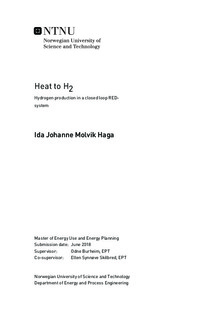Heat to H2 - Hydrogen production in a closed loop RED-system
Abstract
Reverse electrodialysis (RED) in an alternative for production of storable, renewable energy for the future. In the context of climate change, fossil fuel scarcity and internationalagreements such as the Paris Treaty, innovation to secure a sustainable and reliable energy supply is more important than ever.
RED is a technology that takes advantage of salinity gradient power (SGP), or the release of free energy that occurs whenever two solutions containing different concentrations of a salt meet. Ion exchange membranes divide the ions by charge, thus converting chemical potential to electrical potential. The desired final output in this project is hydrogen gas.
A novel use of this technology is proposed, where heat is added to a system as fuel in order to recharge it. The system is otherwise a closed loop, where traditional disposable electrolytes are replaced with recycled KNO3. The recycling is enabled by a separation system, where the electrolytes are restored to their initial states by the addition of low quality heat.
Conductivity measurements on membrane samples clarifies the membrane behaviour in KNO$_3$. Three membranes from Fumatech (Germany) are tested, FAS-50, FAS-30 and FKE-50. The FAS-50 membrane does not display representative conductivity values. FAS-30 and FKE-50 have respective conductivities of 4.3 mS/cm and 4.5 mS/cm at 25 degrees C, and 6.5 ms/cm and 6.6 mS/cm at 40 degrees C.
A bench-scale RED system is planned, realised and tested under operating conditions suitable for the suggested separation systems. Established membrane potentials are maximum 400 mV for a stack containing 4 unit cells, but some of the tested membranes show unsatisfying performance. Higher potentials are expected for membranes with a normal behaviour.
A theoretical model for RED systems is developed. The model shows that ideal execution of the system may yield power densities above 13 W/m2 membrane area, a previously unachieved feat. Further iterations of model parameters and practical application should be performed until the model serves as a true representation of an optimised system.
